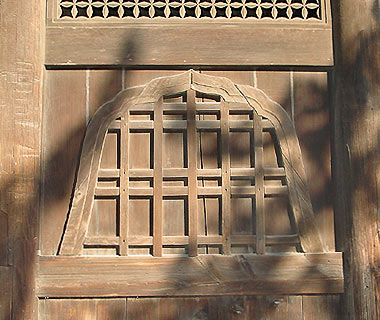|
||
 |
||
| @ |
 |
| Kenchouji Butsuden ·§a (Kanagawa) |
| @ |
@
(C)2001 Japanese Architecture and Art Net Users System.@No reproduction or republication without written permission.
fΪΜeLXgEΚ^ECXgΘΗASΔΜRecΜ³f‘»E]ΪπΦΆά·B
|
||||||
| @ | ||||||
| katoumado@Ξ | ||||||
| KEY WORD :@architecture / general terms | ||||||
| @ | ||||||
| Also
written Τͺ. A synonym for genjimado Ή. The name is derived from
the window in the room called Genji-no-ma ΉΜΤ at Ishiyamadera Hondou
ΞR{°, Shiga prefecture. A window with a special curvilinear
top part called *katou kyokusen
ΞΘό or simply *katou Ξ.
The window has an ogee-type pointed top with a series of S-like curves on
either side of the peak. It dates from end of the Muromachi period
to the Momoyama period. A katoumado is mainly associated
with Zen style *zenshuuyou
T@l temple buildings. The oldest extant example of this window can be found
in the Engakuji *Shariden ~oΙa in Kanagawa prefecture. It is thought to
reflect the Chinese style perfectly. From the latter quarter of the 16c
onward, the use of katoumado appears in temple and shrine buildings,
castles and dwellings. Katoumado are seldom seen in the rustic type
of tea ceremony houses. From the early 17c onward, ogee and S-like curves
became higher and deeper. The vertical frames were widened and sometimes
flared toward the base. Some were embellished with metal ornamentation.
Over time, the frame became almost circular. Example: Nishihonganji Shoin
Taimenjo Ό{θ@ΞΚ (ca 1624) Kyoto. The tendency to develop new shapes resulted
in the warabikatou nΞ where the top of the frame on each side curves
so that the ends meet in the center resembling the shapes of curled bracken
sprouts. This can be seen at Daitokuji Kohouan εΏΗβΙΑ (late 18c) Kyoto.
|
||||||
| @ | ||||||
|
||||||
@ |
||||||
| REFERENCES: | ||||||
| @ | ||||||
| EXTERNAL LINKS: | ||||||
| @@ | ||||||
| NOTES: | ||||||
| @ | ||||||
(C)2001 Japanese Architecture and Art Net Users System.@No reproduction or republication without written permission. fΪΜeLXgEΚ^ECXgΘΗASΔΜRecΜ³f‘»E]ΪπΦΆά·B |
||||||
| @ |